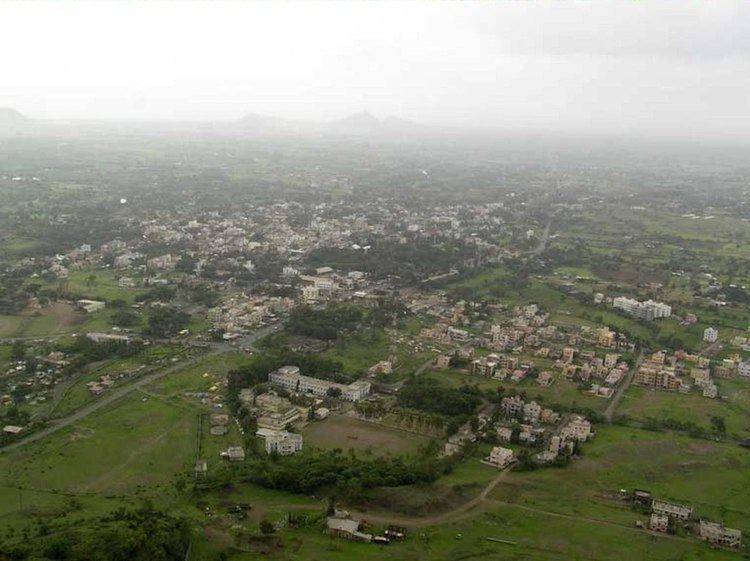Country India District Pune Website [1] Population 24,456 (2001) University SSC College, Junnar | State Maharashtra Time zone IST (UTC+5:30) Elevation 689 m Local time Thursday 1:54 AM | |
 | ||
Weather 23°C, Wind W at 5 km/h, 33% Humidity Neighborhoods Sayyed Wada, Nagar Palika, Pardeshpura | ||
Junnar is a city with thousands of years of history in the Pune district of the Indian state of Maharashtra. The nearby fort of Shivneri is the birthplace of Shivaji, the founder of the Maratha Empire.
Contents
- Map of Junnar Maharashtra 410502
- History
- Geography
- Teak Forest
- Demographics
- Transport
- Junnar Tourism
- Shivneri Fort
- Cave temples
- Agritourism
- Leopard
- References
Map of Junnar, Maharashtra 410502
History
Junnar has been an important trading and political center for the last two millennia. The town is on the trade route that links the ports of western India or more specifically of Konkan with Deccan interiors. The first mention of Junnar comes the Greco -Roman travellers from the first millennium, In the 1400s, the Russian traveler, Afanasy Nikitin spent many months in Junnar during the monsoon season. He describes vividly the life of the Bahamani governor ruling area around Junnar. The Nizam Shahi had Junnar as their first capital. Later in early 1600s, Malik Ambar the Nizam Shahi general moved his capital there. The father of Shivaji, Shahaji Raje worked for Malik Ambar early in his career. Shivaji was born at the nearby Shivneri fort.
Geography
Junnar has an average elevation of 689 metres (2260 feet). State Transport buses run between Pune and Junnar from Shivajinagar ST stand. The Kukadi River flows to the north.
Teak Forest
The Junnar area has been historically famed for its teak forest. The Shaniwar Wada, the de facto seat of government of the Maratha Empire in Pune was completed in 1732 by Peshwa Bajirao I.Teak from Junnar was used extensively in its construction..
Demographics
As of 2001 India census, Junnar had a population of 24,740. Males constitute 52% of the population and females 48%. Junnar has an average literacy rate of 77%, higher than the national average of 59.5%: male literacy is 81%, and female literacy is 72%. In Junnar, 12% of the population is under 6 years of age.
Transport
State Transport buses run between Pune and Junnar from Shivajinagar ST stand from 0630 every hour. Also bus facility available from Mumbai (kalyan) for every 10–30 minutes from 05:20 AM till 12:30 AM. Same is the case from Ahamadnagar and Nashik. Transportation from Ahamadnagar and Mumbai takes a route of NH 222 while from Pune and Nashik will take a route of NH 50.
Junnar Tourism
Junnar area is dotted with historic places including Shivneri , the birthplace of Shivaji maharaj (1630), the cave temple of Lenyadri; One of the famous temple of Lord Ganesha Ozar and the walled town of Junnar itself.
Shivneri Fort
Shivneri , the birthplace of Shivaji Maharaj.
Cave temples
Surroundings of Junnar are very rich with ancient cave temples. In total there are more than 220 individual rock-cut caves located in four hills around Junnar. Junnar has the largest and longest cave excavations in India. The most famous among the caves is the Lenyadri complex. It represents a series of about 30 rock-cut mostly Buddhist caves.. Cave 7 is a famous Hindu temple dedicated to the god Ganesha. It is one of the Ashtavinayak shrines, a set of the eight prominent Ganesha shrines in Maharashtra. Twenty-six of the caves are individually numbered. The caves face to the south and are numbered serially from east to west. Caves 6 and 14 are chaitya-grihas (chapels), while the rest are viharas (dwellings for monks). The latter are in the form of dwellings and cells. There are also several rock-cut water cisterns; two of them have inscriptions. The layout of the caves, in general, are similar in pattern and shape. They generally have one or two sides with two long benches for occupants' use. The caves date from between the 1st and 3rd century AD; the Ganesha shrine situated in Cave 7 is dated to the 1st century AD, though the date of conversion to a Hindu shrine is unknown. All of the caves arise from Hinayana Buddhism.
Agritourism
Agritourism or agrotourism, as it is defined most broadly, involves any agriculturally based operation or activity that brings visitors to a farm or ranch. Few popular such venture, "Parashar Agri & Village Tourism centre", is situated in village Rajuri of Junnar Taluka, and other Rashmigreenland Agri Tourism Center, located at foot hills of Leynadri temple, Golegaon, Junnar
An emerging group of youth from junnar (junnar.in) are trying new trends into business of agrotourism. Arranging Treks, tours, leaving in countryside, tents under the sky are features you can tried out here with them. Easy accessible from Pune, Mumbai and Nashik
Leopard
Many times leopards attack people and animals in Junnar. According to field studies carried out in Junnar, the man-leopard crisis has been wrought about not only by development but by the recent translocations of the leopards that has disrupted the formerly harmonious man-beast coexistence. Very often leopards have attacked villagers in Junnar. There is a leopard rescue centre located at Manikdoh for this cause.
